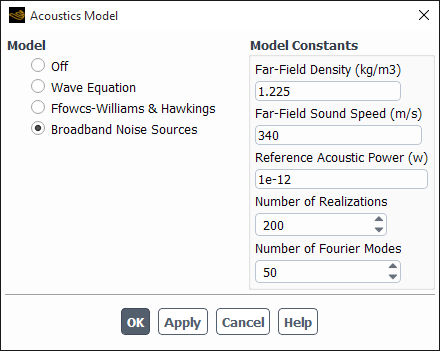In this section, the procedure for setting up and using the broadband noise source models is outlined first, followed by descriptions of each of the steps involved.
The general procedure for carrying out a broadband noise source calculation in Ansys Fluent is as follows:
Calculate a steady or unsteady RANS solution.
Enable the broadband noise model and set the associated model parameters.
Setup → Models → Acoustics
Edit...
Postprocess the noise sources.
Results → Graphics → Contours
Edit...
For additional information, see the following sections:
To enable the broadband noise sources models, select Broadband Noise Sources in the Acoustics Model dialog box (Figure 23.22: The Acoustics Model Dialog Box for Broadband Noise).
Setup → Models →
Acoustics
Edit...
Under Model Constants in the Acoustics Model dialog box, specify the relevant acoustic parameters and constants used by the model. See Enabling the FW-H Acoustics Model for the definitions of Far-Field Density and Far-Field Sound Speed.
- Reference Acoustic Power
(for example,
in Equation 11–19 in the Theory Guide) is used to compute the acoustic power outputs in decibels (dB). The default value is
. Note that the units for the reference acoustic power will be different in 2D (W/m2) and 3D (W/m3) cases.
- Number of Realizations
is the number of samples used in the SNGR to compute the averaged source terms of LEE and Lilley’s equations. The default value is 200.
- Number of Fourier Modes
(
in Equation 11–39 in the Theory Guide) is the number of the Fourier modes used to compute the turbulent velocity field and its derivatives. The turbulent velocity field is then used to compute the LEE and Lilley’s source terms. The default value is 50.
The final step in the broadband noise source modeling process is the postprocessing of acoustic power and noise source data. The following variables are available in the Acoustics... postprocessing category:
Acoustic Power Level (dB)
Acoustic Power
Jet Acoustic Power Level (dB) (axisymmetric models only)
Jet Acoustic Power (axisymmetric models only)
Surface Acoustic Power Level (dB)
Surface Acoustic Power
Lilley’s Self-Noise Source
Lilley’s Shear-Noise Source
Lilley’s Total Noise Source
LEE Self-Noise X-Source
LEE Shear-Noise X-Source
LEE Total Noise X-Source
LEE Self-Noise Y-Source
LEE Shear-Noise Y-Source
LEE Total Noise Y-Source
LEE Self-Noise Z-Source (3D models only)
LEE Shear-Noise Z-Source (3D models only)
LEE Total Noise Z-Source (3D models only)
You can also postprocess results using the Ansys Sound Analysis dialog box. Refer to Postprocessing the FW-H Acoustics Model Data for additional information.



